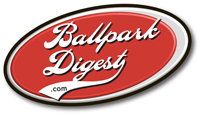The design of Aces Ballpark is a very distinctive combination of new and classic. The basic structure is brick and dark green steel, but the colors in the seating are a warm sand and brick-red color – appropriate for the West.
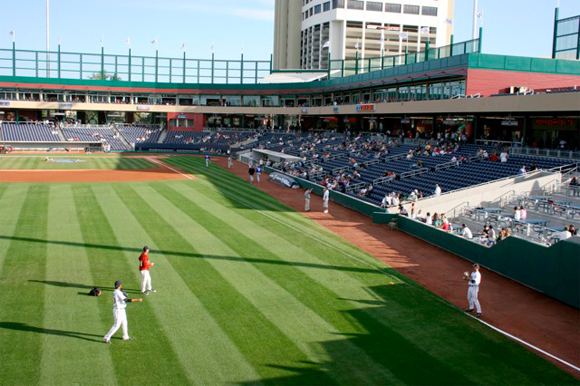
FAST FACTS
Year Opened: 2009
Capacity: 9,100
Cost: $50 million
Dimensions: 338L, 410LC, 423RC, 340R
Architect: HNTB
Construction: Devcon
Website: renoaces.com
Phone: 775.334.4700
League: Pacific Coast League (Triple-A)
Parent: Arizona Diamondbacks
Surface: Grass
Text and Photos By: John Moist
Parking: Valet and handicapped parking is available adjacent to the park, just off Lake Street. Secure bike parking is also available. Reno also has a public transit system (RTC) that serves much of the city and the downtown station is walking distance from the park. (more-casinos, UN etc)
Address/Directions: 250 Evans Avenue, Reno. The ballpark is located about 4 blocks east of Virginia Street, and two blocks north of the National Automobile Museum. From I-80, take Virginia St. or Sierra St. south. Due to the proximity of the casinos, there are many public lots to the east of Virginia St. in walking distance of the ballpark.
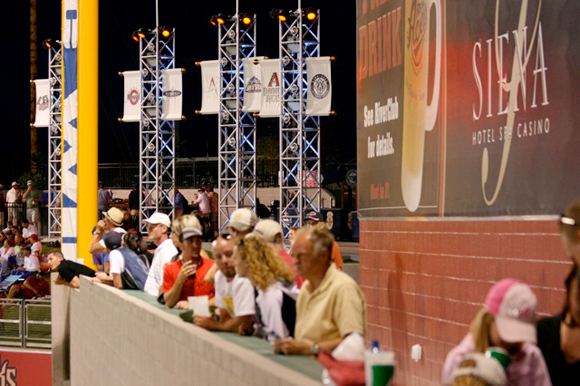
One of the most distinctive features of the park is the left-field wall. At approximately 40 feet, the wall is unusually high, and the wall is topped by a row of high billboards and the scoreboard. Fans can walk up from the left-field party zone and stand along the top of the wall and watch the game from a high vantage point, just under the billboards and scoreboard. The scoreboard includes a large LCD screen for highlights and game information.
The high wall, billboards and scoreboard are presumably designed to protect the Amtrak trains, which run directly behind and below the left-field wall. The tracks are part of the original Transcontinental Railroad, carrying passengers from San Francisco to points east.

As fans continue across the wall, they will reach the Kids Zone playground and the Bullpen Party Deck, the prime outfield concession area, which features a BBQ stand, hot dogs, sodas, beer, and a bar, as well as a well-stocked souvenir stand focusing on kids’ items. Behind this concession area is Baseball Mountain, an attractively landscaped hill with large rocks and colorful plants.
The bullpens are located right behind the right-field wall, and directly behind the pens is the berm. Similar the one in Raley Field in Sacramento, the berm is a fun, inexpensive place to watch the game — arrive early, bring the kids, and spread out blankets. There’s a good view of the game, and the kids can run around, chase homers and get a good look in the bullpens. One of the best, most distinctive features of the Aces Ballpark is located behind the Berm: a series of large, silver railroad-style semaphore lightposts, with lights and flying banners of all the PCL teams. These are distinctive, colorful, functional and highlight Reno’s connection with American railroad history.
Reserved and box seats run from the right-field corner, behind home plate, and down the third-base line to the Coors Party Deck in the left-field corner. The Dugout Suites consist of two rows of very comfortable seats directly behind home and include food service. The concourse is busy, and promotes walking and standing in all areas.
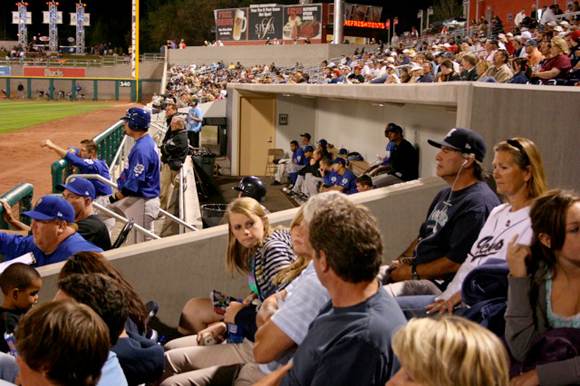
The park has a good variety of food, including brisket and pulled pork sandwiches as well as burgers, dogs and brats. Crafter’s Corner and other beer stands provide an above-average selection of at least eight different micro beers and imports. It should be noted, however, that many of the concessions in the outfield were closed by the fourth inning during our visit.
Another feature of Aces Ballpark is the use of very distinctive signs for the restrooms. The Men’s restroom entrances are designated by a stylized image of Ted Williams swinging the bat, and the women’s restroom entrances sport an image from “A League of Their Own.” These are a clever touch. Other nice touches around the park: the Aces logo on the end of every aisle, and trash cans with large Aces helmets. And there is the Seventh Inning Stretch, where the very large smiling baseball, looking like Mr. Met or the Great Pumpkin, rises from behind the center-field batter’s eye.
Upstairs past third base, the Hall Of Fame Club serves 150, and includes 88 veranda seats, TVs, and a wet bar. Suites stretch around the upper level, which also houses team offices and the press box. An additional press table is located on the lower concourse behind the seating, behind home plate.
All fans receive a free 60-page Scorecard magazine, which includes greetings from the mayors of Reno and Sparks, bios of the owners, manager (Brett Butler), coaches and staff, plus photos, bios and stats on most of the players (minor league rosters change alot!). Funded by local advertisers, this is a great take-home souvenir that fans can refer to, and will remind them to plan a return visit.
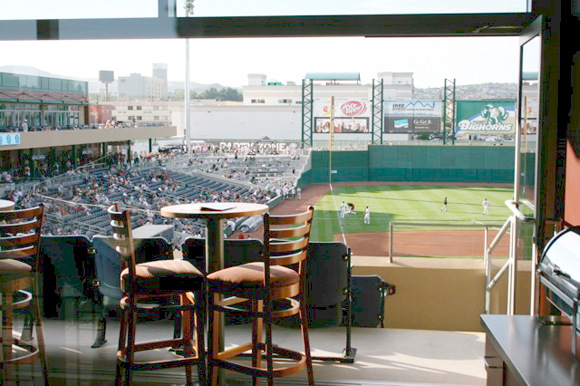
The Team Shop is located at the main entrance. As with many parks, it is accessible from inside and outside the park. The Aces’ shop is larger than most, with an above- average selection of shirts, caps, balls, bats, keychains, mugs, decals and other souvenirs at reasonable prices. The Aces’ classy authentic jerseys (home white and road grey) are also available.
It is a ballpark built in a hurry. Groundbreaking was February 28, 2008, and the park opened on April 17, 2009, a span of less than 14 months.
All in all, Aces Ballpark is a good place to bring the family to watch professional baseball. The park is a valuable asset to the city and will help promote development in the area east of the casinos. The best/unique features: standing room on the high left field wall; the silver railroad style semaphore lightposts; and the fun restroom signs.
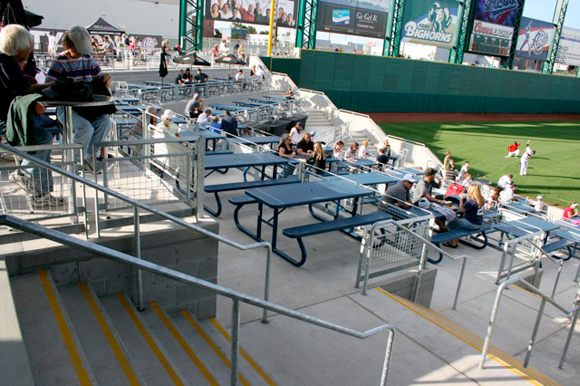
RENO ACES HISTORY
The Tucson Sidewinders migrated west to Reno for the 2009 season, lured by a great new ballpark. The Tucson Toros franchise was established in 1969 as the Pacific Coast League/AAA affiliate of the Chicago White Sox. The Toros club later became the AAA farm team for the Oakland A’s, Texas Rangers and Houston Astros. The club won its first PCL pennant in 1991 with star player Kenny Lofton and skipper Bob Skinner, and won a second flag in 1993. In 1998, Tucson became the affiliate of the expansion Arizona Diamondbacks, moved into the new Tucson Electric Park, and changed the team name to the Sidewinders to extend the snakey theme. In 2008 the team announced it would move to a new ballpark in Reno, and the long history of affiliated minor-league ball in Tucson came to an end.
BEFORE/AFER THE GAME
Reno (“The Biggest Little City in the World”) has a population of about 170,000 and has a number of attractions to visit while you’re there. The National Automobile Museum (10 Lake St. S.), is a short walk just south of the ballpark. The successor to the legendary Harrah’s museum, it houses many classic and collectors’ cars, and is the focal point of Reno’s annual “Hot August Nights” event. The University of Nevada campus, just north of downtown on Virginia Street, includes the Lawler Events Center and the Fleischmann Planetarium and Science Center. Because of the great climate, Reno has lots of outdoor activities, including skiing, and rafting on the Truckee River. There’s even a whitewater park on the Truckee as it runs through downtown Reno. Of course, Reno is best know for its casinos, shows, restaurants and classic neon lights.
Share your news with the baseball community. Send it to us at editors@augustpublications.com.
Subscribers to the weekly Ballpark Digest newsletter see features before they’re posted to the site. You can sign up for a free subscription at the Newsletter Signup Page.
Join Ballpark Digest on Facebook and on Twitter!
